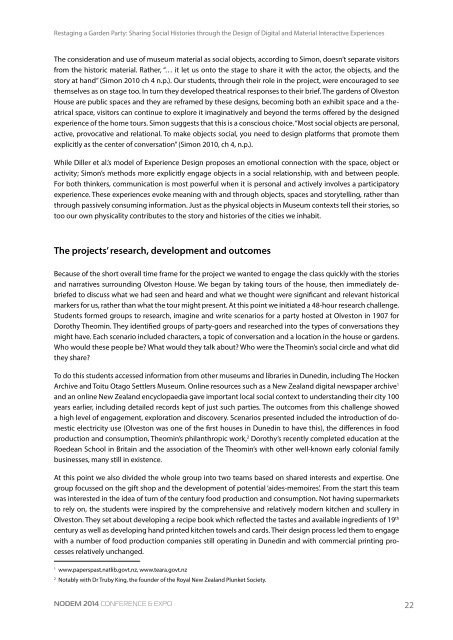NODEM 2014 Proceedings
NODEM 2014 Proceedings
NODEM 2014 Proceedings
Create successful ePaper yourself
Turn your PDF publications into a flip-book with our unique Google optimized e-Paper software.
Restaging a Garden Party: Sharing Social Histories through the Design of Digital and Material Interactive Experiences<br />
The consideration and use of museum material as social objects, according to Simon, doesn’t separate visitors<br />
from the historic material. Rather, “… it let us onto the stage to share it with the actor, the objects, and the<br />
story at hand” (Simon 2010 ch 4 n.p.). Our students, through their role in the project, were encouraged to see<br />
themselves as on stage too. In turn they developed theatrical responses to their brief. The gardens of Olveston<br />
House are public spaces and they are reframed by these designs, becoming both an exhibit space and a theatrical<br />
space, visitors can continue to explore it imaginatively and beyond the terms offered by the designed<br />
experience of the home tours. Simon suggests that this is a conscious choice. “Most social objects are personal,<br />
active, provocative and relational. To make objects social, you need to design platforms that promote them<br />
explicitly as the center of conversation” (Simon 2010, ch 4, n.p.).<br />
While Diller et al.’s model of Experience Design proposes an emotional connection with the space, object or<br />
activity; Simon’s methods more explicitly engage objects in a social relationship, with and between people.<br />
For both thinkers, communication is most powerful when it is personal and actively involves a participatory<br />
experience. These experiences evoke meaning with and through objects, spaces and storytelling, rather than<br />
through passively consuming information. Just as the physical objects in Museum contexts tell their stories, so<br />
too our own physicality contributes to the story and histories of the cities we inhabit.<br />
The projects’ research, development and outcomes<br />
Because of the short overall time frame for the project we wanted to engage the class quickly with the stories<br />
and narratives surrounding Olveston House. We began by taking tours of the house, then immediately debriefed<br />
to discuss what we had seen and heard and what we thought were significant and relevant historical<br />
markers for us, rather than what the tour might present. At this point we initiated a 48-hour research challenge.<br />
Students formed groups to research, imagine and write scenarios for a party hosted at Olveston in 1907 for<br />
Dorothy Theomin. They identified groups of party-goers and researched into the types of conversations they<br />
might have. Each scenario included characters, a topic of conversation and a location in the house or gardens.<br />
Who would these people be? What would they talk about? Who were the Theomin’s social circle and what did<br />
they share?<br />
To do this students accessed information from other museums and libraries in Dunedin, including The Hocken<br />
Archive and Toitu Otago Settlers Museum. Online resources such as a New Zealand digital newspaper archive 1<br />
and an online New Zealand encyclopaedia gave important local social context to understanding their city 100<br />
years earlier, including detailed records kept of just such parties. The outcomes from this challenge showed<br />
a high level of engagement, exploration and discovery. Scenarios presented included the introduction of domestic<br />
electricity use (Olveston was one of the first houses in Dunedin to have this), the differences in food<br />
production and consumption, Theomin’s philanthropic work, 2 Dorothy’s recently completed education at the<br />
Roedean School in Britain and the association of the Theomin’s with other well-known early colonial family<br />
businesses, many still in existence.<br />
At this point we also divided the whole group into two teams based on shared interests and expertise. One<br />
group focussed on the gift shop and the development of potential ‘aides-memoires’. From the start this team<br />
was interested in the idea of turn of the century food production and consumption. Not having supermarkets<br />
to rely on, the students were inspired by the comprehensive and relatively modern kitchen and scullery in<br />
Olveston. They set about developing a recipe book which reflected the tastes and available ingredients of 19 th<br />
century as well as developing hand printed kitchen towels and cards. Their design process led them to engage<br />
with a number of food production companies still operating in Dunedin and with commercial printing processes<br />
relatively unchanged.<br />
1<br />
www.paperspast.natlib.govt.nz, www.teara.govt.nz<br />
2<br />
Notably with Dr Truby King, the founder of the Royal New Zealand Plunket Society.<br />
<strong>NODEM</strong> <strong>2014</strong> Conference & Expo<br />
22


